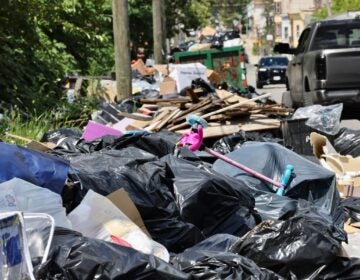East Falls Community Council shows support for latest Queen Lane Reservoir design plan
After years of negotiation, the East Falls Community Council signaled a show of support for revised design features at the Philadelphia Water Department’s Queen Lane Reservoir.
A number of concerns were voiced by community members both publicly and in private discussions with PWD officials in the course of the last few years: Among them, opposition to the proposed eight foot high wrought-iron security fencing – featuring an outward sloping curve – was particularly strong. Subsequently, the PWD agreed to install a straight picket fence.
Also lamented in the past was the forward location of the fencing, which would provide an enhanced security buffer for the facility but would result in the loss of open space, with possible aesthetic impacts on the residential neighborhood adjacent to the facility.
Originally, a 100-foot extension of the fence line was requested by the PWD. In compromise with the community, a 50-foot advancement was agreed to. PWD officials indicated a commitment in subsequent conversations to regrade the remaining space to allow for recreational use upon a gentler slope.
The location and manner of lighting distressed some residents, who also sought additional landscaping and other amenities to the facility. PWD agreed to install reduced glare LED lighting.
In light of the many compromises reached, Paul Elia, an East Falls-based architect who led the discussions with PWD, bestowed his approval upon the current plans.
“Short of a few minor details,” he said, “everyone should be happy.”
Detailing the compromises
“We’ve worked over a long period of time to address each one of these elements,” said Mike Lavery, design branch manager for the PWD, in reference to the number of compromises made to reach the current design.
Referencing community concerns over the “institutional”-like quality of the proposed curved fencing, Lavery reiterated that compromise brought about the decision to select straight picket fencing instead.
With respect to the regrading of the open space in front of the fence line – estimated at adding $30,000 to what is expected to be a multi-million dollar project – Lavery said that the use of the space by residents for recreation is actually a boon for security at the site, as a human presence serves as a deterrent to malfeasants.
In addition, the forward fence line will be softened by the addition of landscaping, particularly at the intersection of Queen Lane and Fox Street. Warning signs along the fence line are expected to be kept to a minimum.
With regard to lighting, Lavery expanded upon earlier announcements that LED lighting would be put into place to combat glare. It’s a little more expensive, he noted – and may require an extra light post – but the PWD, unlike private business, is more concerned with perpetuity than payback.
“Overall, we worked point-by-point over a long period of time to get to this point,” said Lavery, “and I think we’re there.”
Securing formal approval
This observation was echoed by Debra McCarty, deputy commissioner of operations for PWD. “This has been a long process, but a collaborative one,” she said. “We’ve gotten to a good place.”
Despite this diagnosis, there were some complaints voiced by residents present at Monday’s meeting about the appearance of the vegetated curb bumpouts that line Queen Lane.
In response, Lavery said that they are a component of the PWD’s Green City, Clean Water initiative, and that there has been a learning curve in effect, particularly with regard to maintenance of the bumpouts.
“We’d like to be proud of them in the future,” said Lavery.
While pride coalesces, the PWD will need to secure formal approval from the EFCC’s zoning committee before heading to the ZBA as the proposed fencing exceeds the five-foot height specifications of code. Once approval is in hand, bidding for the project is hoped to begin by the end of the current fiscal year.
Community support
Residents present expressed pleasure with the final design and expressed relief that the extended process it brought about was nearing its conclusion.
East Falls resident Kevin Williams recognized the long and hard work that went into the compromises that shaped the current design, and related that the offer to regrade the space along the fence line secured his approval.
“As far as I’m concerned, that takes care of it,” he said.
Tom Sauerman, president of EFCC, said that his organization and the PWD began the project from opposing points of view, but ultimately reached an agreement to their mutual satisfaction.
“This has been a long process,” he said, “but certainly well worth it.”
WHYY is your source for fact-based, in-depth journalism and information. As a nonprofit organization, we rely on financial support from readers like you. Please give today.




